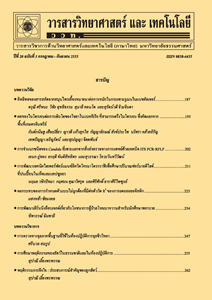ความสัมพันธ์ทางพันธุกรรมของชนิดกล้วยไม้ในสกุลเอื้องเทียนด้วยไอเอสเอสอาร์
Main Article Content
Abstract
บทคัดย่อ
กล้วยไม้สกุลเอื้องเทียน (Coelogyne) เป็นพืชอิงอาศัยที่มีดอกขนาดใหญ่และสวยงาม จัดเป็นกล้วยไม้ที่พบตามธรรมชาติได้ยาก เนื่องจากมีปัจจัยจํากัดหลายด้านที่ส่งผลต่อการงอกของเมล็ดและการเจริญเติบโต ปัจจุบันพบว่าเอื้องเทียนในธรรมชาติลดปริมาณลงอย่างรวดเร็วและเสี่ยงต่อการสูญพันธุ์ อีกทั้งการจำแนกด้วยลักษณะสัณฐานทำได้ยากและต้องอาศัยผู้ความเชี่ยวชาญที่มีประสบการณ์ ดังนั้นงานวิจัยนี้จึงสร้างลายพิมพ์ดีเอ็นเอของเอื้องเทียน จำนวน 14 ชนิด ด้วยเทคนิคไอเอสเอสอาร์ โดยคัดกรองไพรเมอร์ไมโครแซทเทลไลต์ 35 ชนิด สำหรับใช้ประเมินความสัมพันธ์ทางพันธุกรรม พบว่าไพรเมอร์ 14 ชนิด สามารถเพิ่มปริมาณดีเอ็นเอได้ และไพรเมอร์ 9 ชนิด ให้แถบดีเอ็นเออย่างชัดเจน ขนาด 500-2,000 คู่เบส รวมทั้งหมด 203 แถบ โดยมีแถบดีเอ็นเอที่จำเพาะกับชนิดกล้วยไม้สกุลเอื้องเทียนแต่ละชนิด จำนวน 17 แถบ เมื่อสร้างแผนภูมิความสัมพันธ์ด้วยโปรแกรม NTSYS รุ่น 2.0 พบว่าเอื้องเทียนลำเขียวมีความสัมพันธ์ทางพันธุกรรมใกล้ชิดกับเอื้องลำเทียนปากดำมากที่สุด โดยมีค่าสัมประสิทธิ์ความคล้ายเท่ากับ 0.63
คำสำคัญ : เอื้องเทียน; ความสัมพันธ์ทางพันธุกรรม; ไอเอสเอสอาร์
Abstract
Coelogyne are epiphytic plants, which have large and beautiful flowers. These orchids are rare in the nature because of the limited factors that affect growth and seed germination. Recently, the native Coelogyne have dramatically reduced, extinction and them morphological identification is much more difficult and need the expert who experienced. In this research, the DNA fingerprints were generated to evaluate the genetic relationships among 14 Coelogyne species by using inter-simple sequence repeat (ISSR) techniques with 35 microsatellite primers. The results showed that 14 primers were capable to DNA amplification and 9 primers were gave 203 clearly DNA bands with about 500-2000 bp in sizes. Moreover, 17 DNA bands were specific to each orchid species. The dendrogram was constructed using NTSYS (version 2.0) software based on the comparison of similarity coefficients used for cluster analysis, Its was found that Coelogyne lentiginosa and Coelogyne brachyptera were most closely related with similarity coefficient of 0.63.
Keywords: Coelogyne; genetic relationship; ISSR (inter-simple sequence repeat)


